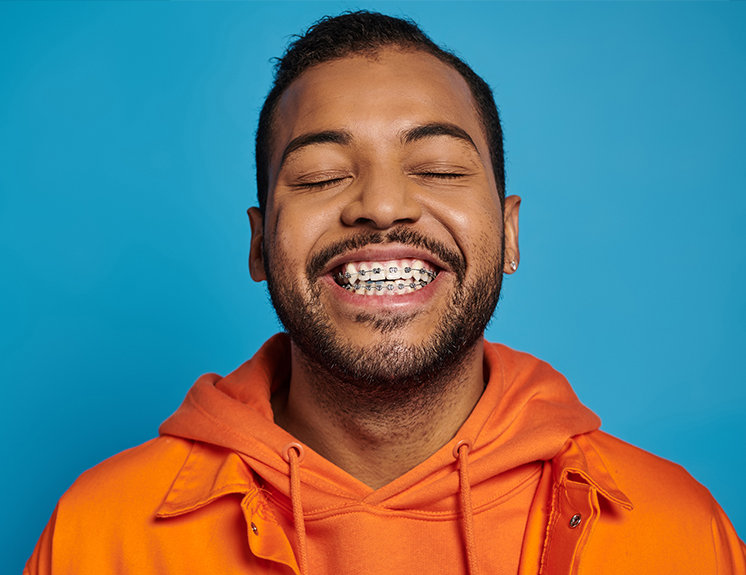Braces work remarkably well.
Ask the average person on the street about braces, and they’ll probably tell you they help move teeth into place. Unless that person happens to be an orthodontist, they probably can’t tell though “how do braces work?“
That’s where we come through for you. In this guide, you’ll learn exactely how braces work, including the main three parts that make braces move your teeth into a healthier, straighter smile you’re going to love.
Braces Guide Contents
- 3 Main Parts
- How Teeth Move
- Do Braces Hurt?
- Adults & Kids


What makes braces work?
Braces have 3 main components.
An orthodontist may use any number of treatments or appliances to straighten teeth.
In this guide, we’ll walk through the three most important components of braces. We’re also going to explain how each part works to achieve the smile goals you’re wanting to see!
BRACKETS
ARCHWIRES
O-TIES, LIGATURES, OR CLIPS
A bracket is the small metal part of the braces that is bonded to your teeth. The bracket doesn’t actually move any of the teeth; rather, it acts as a handle for the other parts.
Brackets can come in several different designs and styles. It is up to the orthodontist’s discretion on what design or style will be the right fit for you or your child.
Once the proper bracket is chosen, it is bonded to the teeth using dental adhesive (a material similar to what is used for white fillings). Once the bracket is bonded to your tooth, the tooth can then be engaged with the next part of braces – the archwire
An orthodontic archwire is what actually moves your teeth into place. First though, an archwire must be turned into the ideal shape for your teeth.
The archwires are springy, so even after they are placed in your mouth and set into place by the brackets, the archwires will still want to spring back into their original position. As the archwires slowly return to their original shape, they pull your teeth along with them. This is the technical process behind moving your teeth into their ideal position.
In nearly every case, the orthodontist will begin your braces with a very thin and flexible wire. That way the wire is exerting very little force, and therefore very light amounts of pressure, on your teeth. As your teeth gradually straighten, the orthodontist will use thicker and stiffer wires to gradually move your teeth into the ideal position.
In order to move teeth with an archwire, an orthodontist needs to attach the wire to the bracket. This is where the final key part of braces, o-ties or bracket clips, come in.
O-ties or “orthodontic ligatures” are the little colored elastics that go around your braces. These little colored rings may be the most flashy part about braces, but they aren’t around just for style – they help to pull the archwire into the bracket and “ligate” or tie the wire into the bracket.

How braces work.
Now for the part you’ve really been wondering about…how do braces work?
How do they actually get teeth to move?
To help you understand how teeth are able to move, it’s first helpful to get a basic anatomy lesson. Let’s learn about the teeth, jawbone, and gums.
The roots of your teeth are surrounded by bone. When a steady and consistent outside force is applied to a tooth over a long period of time, the bone on one side of the tooth is removed by cells in your blood and new bone is laid down on the other side of the tooth. Your tooth essentially forges a new path provided by bone.
When a tooth moves, the bone, gums, blood vessels, and everything else travel along with the tooth to help it travel safely and securely into a new position.
Alright, now how do braces fit into this process?
The archwire, with the help of the bonded brackets, place consistent pressure on the teeth. This pressure signals the cells in your blood to start removing bone from the current position and building bone in the new position that the pressure wants your tooth to go.
The important thing to know here is that tooth movement takes time, even with braces. At your first braces visit, you can expect a small wire that applies very light pressure to the teeth. This wire will be kept on for about 4-8 weeks. After this period of time, the pressure mostly goes away. On your second visit, a slightly stiffer wire is placed into position, and the teeth begin feeling pressure again, making new bone and moving along.
This cycle continues every 4-8 weeks until the orthodontist sees that your teeth have finally moved into the ideal position for a healthy and happy smile.
We know you’ve heard stories.
Do braces hurt?
While the amount of pain one feels is often relative, you can typically expect to experience soreness early on. To understand why teeth sometimes get sore with braces, let’s compare this to running.
If you haven’t run in a long time, but one day go out and run several miles, your legs will inevitably feel sore and tight the next day. This is because the muscles in your legs were not used to the activity and movement created by long distance running.
But if, after several days or weeks, you have been running consistently, your legs will get used to it and lose that day-after soreness.
It’s the same way with braces and teeth!
The first time that your teeth begin moving (when you first get your braces on), the nerves around your teeth go through an inflammatory process. During the first couple of days that you get braces you will likely have sore teeth.

Is it the same process?
Adult Braces vs Kid’s Braces
The biology of tooth movement is the same for adults and kids. The only difference is that kids’ bodies are in “growth mode”, which means that things just happen more rapidly. Kids’ teeth, in general, will move more rapidly with braces than adult’s teeth.
Adult’s teeth will still move, but the rate of tooth movement will usually be a bit slower. So if you’re an adult who needs braces, you may have a few more cycles with brackets, archwire and ligatures – or you may not. See what we mean below…
As you can see, a patient’s age is only one factor of many that determine just how long braces take. Because adults tend to brush their teeth better and follow the instructions of the orthodontist, many times their treatment may be faster than a teenager.
Whether you’re an adult, child, or teenager there’s never a bad time to get started on getting a straight and healthy smile!

